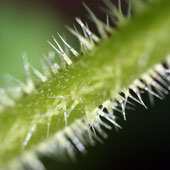Hikers often brush up against injurious plants, such as poison oak or thorny shrubs. One particularly vexing plant is the “ubiquitous weed, Urtica dioica,” commonly known as stinging nettles. As described in an article entitled “Mechanism of Action of Stinging Nettles” (Wilderness & Environmental Medicine:22,136-139,2011) by Alexander Cummings and Michael Olsen, direct contact exposure to the weed causes immediate stinging and burning sensation on the skin. The authors exposed mouse skin to the plants and looked at this skin using an electron microscope. They found smooth nettle spicules that had pierced the skin surface, a few of which retained their bases, which appeared empty of liquid contents. The authors concluded that the mechanism of action of stinging nettles skin reaction was both biochemical and mechanical, likely caused by impalement of spicules into the skin.
 Spicules of a stinging nettle, photo courtesy of Randy A. Nonenmacher (CC BY 3.0)The spicules are present as small “hairs” that are found on the stem and undersides of the leaves of the plant. Even light touch against the plant can cause a reaction, which is often characterized as instantaneous burning, itching, and sometimes a slight swelling of the skin. The nettles have been found to contain biologically active chemicals, which might account for part or all of the reaction. This current study shows that spicules, in whole or in part, are retained in the skin. To what extent the mechanical effect of spicule retention contributes to the reaction is yet to be determined, but it is certainly possible that there is such a mechanical effect.
Spicules of a stinging nettle, photo courtesy of Randy A. Nonenmacher (CC BY 3.0)The spicules are present as small “hairs” that are found on the stem and undersides of the leaves of the plant. Even light touch against the plant can cause a reaction, which is often characterized as instantaneous burning, itching, and sometimes a slight swelling of the skin. The nettles have been found to contain biologically active chemicals, which might account for part or all of the reaction. This current study shows that spicules, in whole or in part, are retained in the skin. To what extent the mechanical effect of spicule retention contributes to the reaction is yet to be determined, but it is certainly possible that there is such a mechanical effect.
It is not known if removing spicules soon after they enter the skin might be helpful, but it seems logical to make the attempt. There aren’t great ways to do this, because the spicules are so tiny and numerous. It is possible that a peeling method, in which the sticky side of adhesive tape is applied to the skin and then removed, might be helpful. It is certainly worth a try, if someone encounters stinging nettles and can rapidly get their hands on some tape (e.g., is carrying it with them).
Reprinted with permission by the Author from Healthline.com


